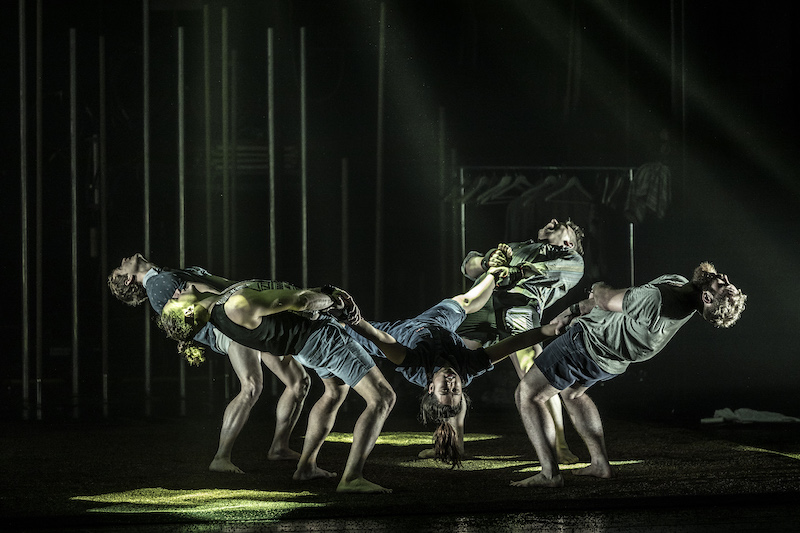Review from: Underbelly at McEwan Hall, Edinburgh Festival Fringe; 6th August 2019
Edinburgh Fringe has a daunting amount of acrobatic talent in it this year, and the GOM troupe are up there with Circa at the pinnacle of full-length acrobatic choreography that refuses to be theatre or dance but is its own type of embodied raw circus spectacle spectacle. I wrote about another show this festival as generating an ‘art gallery mode‘ of watching. Backbone, like Circa’s Humans, finds me watching in an ‘orchestral mode’ – the dynamically shifting rhythms of polyphonic acrobatics and the richness of its evolving composition reminds me of listening to a world class orchestra, shifting seamlessly from one mood to another visually the way a musical concerto does for your ears. Of course, Backbone has live music performed onstage too, so this is a full-body concert of ensemble strength and skill for multiple senses. There are moments of tension and heart-dropping suddenness for my insides, and the feel of air pushed past my skin – displaced by spinning and pitching bodies onstage – for my outsides. OK, they don’t give me anything to taste or smell, but I have my coffee.
The total cast of acrobats are Jacob Randell, Jascha Boyce, Lachlan Binns, Alyssa Moore, Kevin Beverley, Jordan Hart, Rachael Boyd, Lachlan Harper, Joren Dawson, Jackson Manson, Nick Martyn, Alexey Kochetkov. The show was directed by Darcy Grant, and the lighting design of turquoise darts and purple haze that intersperse the brighter scenes is by Geoff Cobham.
Props come in the form of three objects, repeated, like the human bodies, in ten varieties. There is a poetic object – heavy lumps of rock that add weight and threaten danger, and allow moments for metaphorical images to rise and fall out of the mix. There is a comical object: shining metal buckets that sit over heads or empty soil onto the stage to be patterned by the cast’s movement (sadly, I can’t see these patterns from my seat in the seventh row at McEwan Hall. Here, sitting higher up and further back would be an advantage. If anyone else was wondering, like me, whether the grains had a function besides the aesthetic, the answer is yes – it’s actually fine rubber pellets that aid the spring on the stage surface!). There is also an adaptable, pragmatic object: wooden poles ranging from around four to ten feet in length that balance on foreheads or support the weight of one of the cast in the sort of display that used to be considered magic.

It’s hard to talk about Backbone without mentioning the original GOM smash-hit A Simple Space. This show starts out using a very similar formula of training games and competition between the cast members, but is bigger and bolder, and goes on to develop into something new. Backbone is a more serious show, as comic moments in the early sections fade into the background and intricate patterns of acrobatics take focus. That’s not to say there isn’t some humour in their choreography, but it doesn’t have me in laughing out loud like their first show did. Backbone has gained in polish and production and technical skill, but I do miss the old sense of direct connection with us in the audience.
Everything builds in Backbone, until the final exhaustion of reaching an ultimate limit. From flat planes to geometric lines, from horizontal and vertical to rotation on these axes, from combinations of one or two performers to complex sequences featuring all ten acrobats. Do you remember the game Mousetrap, where one moving piece triggers a chain reaction of moving elements? That’s what GOM creates on stage with their own bodies. After we see these sequences clearly illustrating the influence of each person’s movement on the totality of the composition, the complexity and precision of the choreographies that continue later at speed is really brought into focus.
The backbone of the title seems to be the company’s intimate knowledge of each other’s every move and reliance on each other through deep, communal trust. I hate myself a little bit for writing this, because ‘ooh, look at the trust’ has kind of become a recent circus review cliché, but here it seems to be a pertinent point to the show, rather than a by-the-by consequence of circus necessity. It is amazing, and it gives me hope for humankind’s ability to work together.




